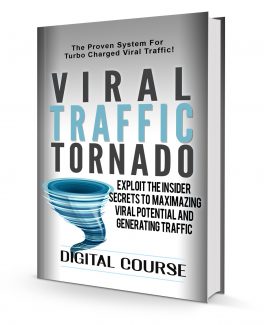 License Type: Personal Use
License Type: Personal Use  File Type: ZIP
File Type: ZIP
 SKU: 59737
SKU: 59737  Shipping: Online Download
Shipping: Online Download
Ebook Sample Content Preview:
Chapter 1: Viral Marketing for Your Online Businesses The Elements of a Successful Viral Campaign
When you're planning your viral marketing strategy, it's important to keep in mind the basic requirements of every viral campaign. Without these, your stampede might turn out to be more like a leisurely stroll.
To build a good viral campaign, make sure your plan includes
A free product or service
The product has to be easily transferable to another person
It has to be able to scale easily
It has to take advantage of other people's resources
It has to be unique, original, and relevant
Over the next few pages, we’re going to take a look at each of these elements, and examine how you can use them to design and launch your own viral campaign. Don't worry. It's not as complicated as it looks!
There's A Free Lunch, And You're Serving It!
Every single viral campaign begins with giving something away. Every one. It could be an ebook, a piece of software, an instructional video, or even a few laughs, but it has to be free. And when we say free, we mean free. Not free with an opt-in or a free trial. It has to be really free, because you're going to encourage your customers to share it with their friends, and no one wants to tell their sister she has to sign-up for your list to get the cool thing you're giving away. Now that doesn't mean you're giving away the farm. But you do need to give away great stuff. There's lots of ways you can do that, while still leaving your customers wanting more.
For example, if you build and sell a software package that helps bloggers find free photos for use on their blog, you could offer a free version of the software that only searches one database instead of several. Or if you've written an ebook, you might release one chapter for free.
One thing to remember, though, is that the free product must be useful all by itself. You're not releasing a free trial, you're essentially building two products. One which you'll give away and one which you will sell, and they both need to be valuable to your users. Free software that is so limited as to be worthless is not a good candidate for a viral campaign. The same is true for a chapter of an ebook that ends with a question.
Some marketers pull just this sort of trick to "force" customers to upgrade, but very often it will backfire. Customers are savvy, and they dislike being manipulated this way, so don't make the mistake of thinking you'll lose sales by giving away too much information, because the opposite is actually true. You'll gain sales by giving away great stuff. Especially if your great stuff is easy for your users to share among their friends, family, and colleagues.
Share and Share Alike
The second element of a fantastic viral marketing campaign is the ability of your customers to share your product with their peers. Think about the hundreds of email forwards you get in a year. That's because people love to share great stuff. Good marketers know this and take advantage of it by providing their customers with what they want, and then they sit back and watch it spread.
Social Networks Traffic 101
Viral campaigns thrive on the Internet largely because of the social networks that exist. Ten years ago marketers had to rely on telephones and email (maybe) to get the word out about a new product or a great service. You can imagine the results were unpredictable and slow to materialize.
Today, we have dozens – maybe even hundreds – of social networks to use to get our message to the masses. But for some, that means having the opposite problem: where do you start? For an online marketer, the first place to start is with your very own email list. These are the people who already know you, like you, and buy from you. They're your biggest fans, and they're the ones who are most likely to pass your great products on to their family and friends and social network. So make sure you're keeping them informed about the latest products you're developing, any contests you're holding, or any other thing that's going on that they might want to share.
You probably have an account with several of the more popular social networking sites, like Facebook and Twitter. But for viral marketing to work in these venues, you have to be hanging out with the right crowd. If you use Facebook primarily for friend and family interaction, trying to launch a viral campaign there is probably not a good move.
The same goes for Twitter and Google Plus. Do you follow those in your niche, or those who are other marketers? If it's the latter, your niche campaign won't have very good results here either. Instead, make an effort to follow those who share your passion for your niche, instead of those who are simply marketing their own online business. Now if your niche is internet marketing, then you should be following other marketers, but that's the only exception. Concentrate on following – and being followed by – those who are in your niche, but who are not necessarily selling in your niche. In other words, you want to be hanging out with the buyers, not the sellers.
For strictly social interaction, Google Plus, Facebook and Twitter are your number one choices. If your target market is other business owners, though – say for example you sell a product aimed at accountants – you need to get on LinkedIn. If you're not familiar with it, LinkedIn is basically a database of business professionals in all areas of expertise. It's similar to Facebook, but without the games and other social activities.
LinkedIn allows you to network with other professionals in your area of expertise, form groups, organize meetings, and develop a vast network of colleagues you can reach out to through private messaging or by posting status updates. You can automate your LinkedIn updates just like you can with Facebook and Twitter, and even link your other social network accounts so everything is up to date. If your product is geared toward professionals, LinkedIn is the social network of choice.
For viral campaigns built around funny videos, great photography, comic strips, or other visual media, StumbleUpon is the social network of choice. A combination of a social application and a bookmarking service, StumbleUpon is where you go when you're looking for new stuff on the Internet. Just click the button on your toolbar, and you'll be transported to the next interesting thing as determined by the choices you made when you signed up. Like animals? StumbleUpon will serve up a random cat video or heartwarming dog story. Into sports? You might land on a video of Tiger Woods hitting a hole in one, or an ad for a new kind of practice ball.
Of course, getting your content to go viral on a social network involves more than just putting it out there and hoping for the best. Later on we'll discuss how you can give your campaign a virtual push to get it started, but for now, just be aware of the options available in the social networking world. Each has its own purpose and followers, so pay attention to where your customers hang out to determine the best social networks for your needs.
Learn To Utilize Your Friends And Their Resources
Leveraging the power of your own network is an important aspect of any successful viral campaign. Chances are some of your friends are marketers just like yourself, and chances are they've got mailing lists, blogs, and Twitter followers in related, complementary niches. These are powerful assets you can use when it comes to launching a viral campaign.
Here's a short list of ways you can leverage the resources of other marketers to get the word out about your new campaign:
• Buy ad space on related blogs
• Guest post on related, but non-competing blogs
• Buy ad space in newsletters or networks in your niche
• Offer affiliate commissions for lead generation
• Make yourself available for interviews about your product or business
Under that you will see a breakdown of the traffic by country. This gives you an idea of the national demographic you may be targeting. You may think all sites are geared towards the US market, but that's not so. Once you understood who is coming to visit your competitors' sites, you will have a better understanding of how to build and market your own sites.
Make It Special
The final element of any viral marketing campaign is its uniqueness. The same old eBook offering the same old, seen-it-everywhere plan for planning a destination wedding isn't likely to go viral. But add a new twist or your unique take on it, and suddenly it has potential.
That doesn't mean you have to invent a new way to train dogs, though. It just means you have to offer a unique view. In other words, be yourself. You'll get a lot further by giving your eBook or video or podcast your own voice than you will with simply rehashing what others have already said many times over.
Another way to add a unique flair to your content is by giving away checklists, printable workbooks, and other user-friendly features that can't be found elsewhere. We'll talk about that some more in the section on creating viral eBooks, but for now just remember that unique and unusual products and marketing campaigns will spread faster and farther than anything else. You can see that all these elements go together like a jigsaw puzzle. Without all of them, the picture is incomplete, and they all rely on each other to work. Without the resources of your friends, your social networking strategy won’t work as well or be as far reaching. Without a good product, your friends and readers won't be likely to share it with others. Without a great distribution network, it won't matter how good your product is, because no one will see it.
Software
Free software lends itself quite naturally to a viral campaign. It fits all the requirements we discussed earlier for successful viral marketing – it's free; it's easily transferable; it's easily scalable; it uses other's resources; and it's unique. Some examples of software that's gone viral include
• Article submission programs or automation programs
• WordPress plugins – and WordPress itself!
• Games (they don't have to be big or elaborate)
• iPhone or Android apps
• Browser add-ons
• Note-taking and organizing applications like Evernote
But before you decide you want to write a software package, you need to consider the special requirements of software. First, it has to work across multiple platforms. Unlike video hosted on YouTube or a pdf file, software has the added problem of so many possible configurations of computers to deal with. Is your end user running Windows XP? Vista? Or even Windows 97? What about the video adapter? You can see that a lot of thought has to go into the development of a large-scale software package, so it's not something to be taken lightly.
The second obstacle to software creation is ongoing support. You can't just throw out a piece of code and let it drift off without a support plan – not even a free piece of code. If you don't have plans to upgrade, fix bugs, and improve your software down the road, you might be better off sticking with eBooks and videos.
That doesn't mean you have to invent a new way to train dogs, though. It just means you have to offer a unique view. In other words, be yourself. You'll get a lot further by giving your eBook or video or podcast your own voice than you will with simply rehashing what others have already said many times over.
What's In It For Me?
With that said, though, software can quickly go viral and build a fantastic revenue stream for you, even if the software itself is free. Here's a few ideas you can use to monetize free software:
• Offer a limited functionality free version, with an upsell to the fully functional paid version. Remember though, the free version must be useful as it stands if you hope to get a viral stampede started.
• Sell ad space in the software itself. Evernote does this well, with one small, unobtrusive ad in the corner.
• Use a link-back strategy to build brand awareness. This is perfect for WordPress plugins. Distributing free software isn't much different than distributing other forms of content. You can host the files on your own server (remember to use caution here if you plan on going viral!), host them on free file sharing sites, upload them to CNET or ZDNET or SourceForge servers, or – in the case of WordPress plugins – distribute them through the WordPress Codex.
The Basics of Going Viral
Can you force a viral stampede? Probably not. But there are things you can do to give your marketing tactics a nudge that might just send them over the edge.
Great content. This cannot be stressed enough. Without this, no matter how much effort you put into your marketing strategy, people are just not going to pass on links or eBooks or newsletters that aren't any good. Make an effort to go the extra mile for your readers, and they'll reward you by bringing in new customers for you.
Before we get into the specific aspects of viral marketing, what it means and how to implement it, let’s spend a little time discussing the concept of traditional marketing, what it is, how to implement it.
- License: Personal Use
- Category:Ebooks
- Tags:2017 Ebooks Personal Use








